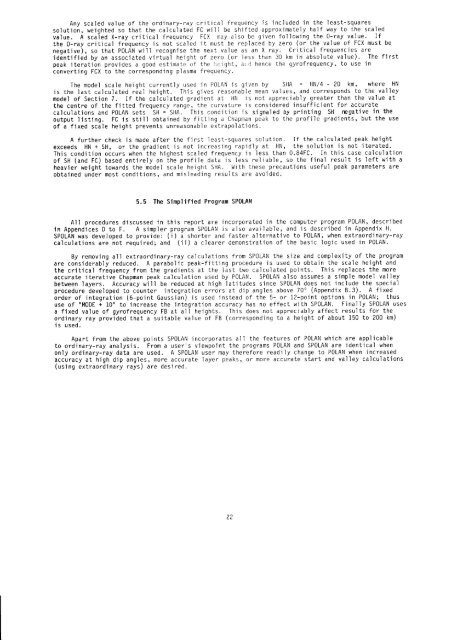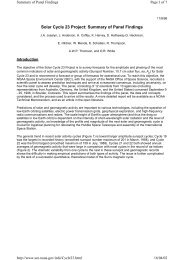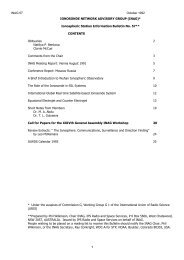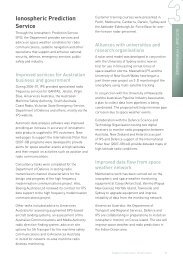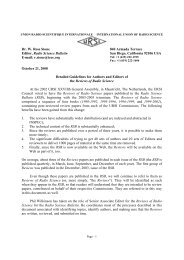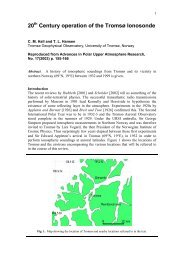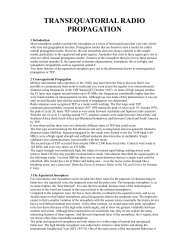UAG-93: Chapters 1 to 5 - URSI
UAG-93: Chapters 1 to 5 - URSI
UAG-93: Chapters 1 to 5 - URSI
You also want an ePaper? Increase the reach of your titles
YUMPU automatically turns print PDFs into web optimized ePapers that Google loves.
Any scaled value of the ordinary-ray critical frequency is included in the least-squares<br />
solut'ion, weighted so that the calculated FC wjll be shifted approxjmately half way <strong>to</strong> the scaled<br />
value. A scaled X-ray critical frequency FCX may dlso be qiven following the 0-ray value. If<br />
the 0-ray critical frequency is not scaled it must be replaced by zero (or the value of FCX must be<br />
negative), so that P0LAN will recognise the next value as an X ray. Critical frequencies are<br />
jd6nt'ified by an associated virtuat freight of zero (or less than 30 km in absolute value). The first<br />
peak iteration provides a good estimate of the i;sight, ai,il hence the gyrofrequency, <strong>to</strong> use'in<br />
converting FCX <strong>to</strong> the corresponding plasma frequency.<br />
The model scale he'ight currently used in POLAN is given by SHA = HN/4 - 20 km, where HN<br />
is the last calculated real height. Th'is gives reasonable mean values, and corresponds <strong>to</strong> the va11ey<br />
model of Section 7. If the calculated gradient at HN js not apprec'iably greater than the value at<br />
the centre of the fitted frequency range, the curvature is cons'idered insufficient for accurate<br />
calculat'ions and POLAN sets SH = SHA. This condit'ion is signaled by printing SH regative in the<br />
output f isting. FC is st'ill obtained by fjtting a Chapman pedk <strong>to</strong> the profiie gradients, but the use<br />
of a fixed scale height prevents unreasonable extrapolations.<br />
A further check is made after the first least-square solutjon. If the calculated peak height<br />
exceeds HN + SH, or the gradient is not increasing rapid'ly at HN, the solution is not iterated.<br />
This condition occurs when the highest scaled frequency is less than 0.B4FC. In this case calculatjon<br />
of SH (and FC) based entirely on the profile data js less reliable, so the final result is left w'ith a<br />
heavier weight <strong>to</strong>wards the model scale height SHA. With these precautions useful peak parameters are<br />
obtained under most conditions, and misleading results are avoided.<br />
5.5 The Simplified Program SPOLAN<br />
All procedures discussed in this report are incorporated in the computer program P0LAN, described<br />
in Appendices D <strong>to</strong> F. A simpier program SP0LAN is also avajlable, and'is descrjbed in Appendix H.<br />
SPQLAN was developed <strong>to</strong> provide: (i) a shorter and faster alternative <strong>to</strong> POLAN, when extraordinary-ray<br />
calculations are not required; and (ii) a clearer demonstration of the basic logic used in P0LAN.<br />
By removing a1l extraordinary-ray calculations from SPOLAN the size and complexity of the program<br />
are considerably reduced. A parabolic peak-fitting procedure is used <strong>to</strong> obta'in the scale height and<br />
the crit'ical frequency from the gradients at the last two calculated points. This replaces the more<br />
accurate iterative Chapman peak calculation used by POLAN. SPOLAN also assumes a simple model valley<br />
between layers. Accuracy will be reduced at high latitudes since SPOLAN does not include the special<br />
procedure developed <strong>to</strong> counter integration errors at dip angles above 70" (Appendix B.3). A fixed<br />
order of integration (6-point Gaussian) is used instead of the 5- or 12-point options in P0LAN; thus<br />
use of "M0DE + 10" <strong>to</strong> increase the integration accuracy has no effect with SPOLAN. Fina'lly SP0LAN uses<br />
a fixed value of gyrofrequency FB at all heights. This does not appreciably affect results for the<br />
ordinary ray provided that a suitable value of FB (corresponding <strong>to</strong> a height of about 150 <strong>to</strong> 200 km)<br />
i s used.<br />
Apart from the above points SP0LAN incorporates all the features of POLAN which are applicable<br />
<strong>to</strong> ord'inary-ray analysis. From a user's viewpoint the programs POLAN and SPOLAN are 'identical when<br />
only ordinary-ray data are used. A SP0LAN user may therefore readily change <strong>to</strong> POLAN when 'increased<br />
accuracy at high dip ang'les, more accurate layer peaks, or more accurate start and valley calculations<br />
(using extraordinary rays) are desired.<br />
aa


